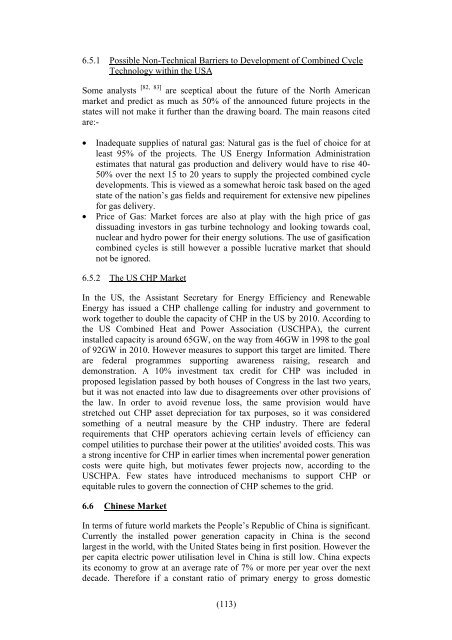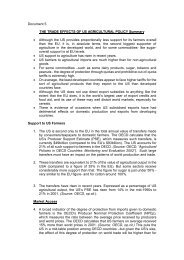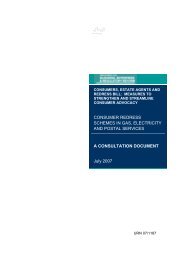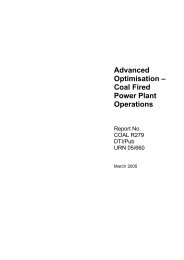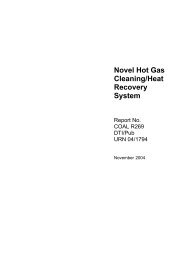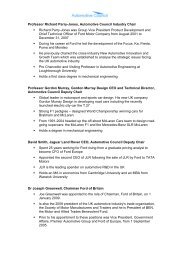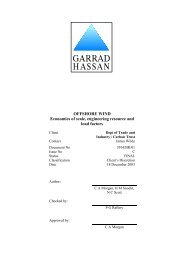(70) Therefore, the risk of sulphuric acid dew point attack ... - DTI Home
(70) Therefore, the risk of sulphuric acid dew point attack ... - DTI Home
(70) Therefore, the risk of sulphuric acid dew point attack ... - DTI Home
Create successful ePaper yourself
Turn your PDF publications into a flip-book with our unique Google optimized e-Paper software.
6.5.1 Possible Non-Technical Barriers to Development <strong>of</strong> Combined Cycle<br />
Technology within <strong>the</strong> USA<br />
Some analysts [82, 83] are sceptical about <strong>the</strong> future <strong>of</strong> <strong>the</strong> North American<br />
market and predict as much as 50% <strong>of</strong> <strong>the</strong> announced future projects in <strong>the</strong><br />
states will not make it fur<strong>the</strong>r than <strong>the</strong> drawing board. The main reasons cited<br />
are:-<br />
• Inadequate supplies <strong>of</strong> natural gas: Natural gas is <strong>the</strong> fuel <strong>of</strong> choice for at<br />
least 95% <strong>of</strong> <strong>the</strong> projects. The US Energy Information Administration<br />
estimates that natural gas production and delivery would have to rise 40-<br />
50% over <strong>the</strong> next 15 to 20 years to supply <strong>the</strong> projected combined cycle<br />
developments. This is viewed as a somewhat heroic task based on <strong>the</strong> aged<br />
state <strong>of</strong> <strong>the</strong> nation’s gas fields and requirement for extensive new pipelines<br />
for gas delivery.<br />
• Price <strong>of</strong> Gas: Market forces are also at play with <strong>the</strong> high price <strong>of</strong> gas<br />
dissuading investors in gas turbine technology and looking towards coal,<br />
nuclear and hydro power for <strong>the</strong>ir energy solutions. The use <strong>of</strong> gasification<br />
combined cycles is still however a possible lucrative market that should<br />
not be ignored.<br />
6.5.2 The US CHP Market<br />
In <strong>the</strong> US, <strong>the</strong> Assistant Secretary for Energy Efficiency and Renewable<br />
Energy has issued a CHP challenge calling for industry and government to<br />
work toge<strong>the</strong>r to double <strong>the</strong> capacity <strong>of</strong> CHP in <strong>the</strong> US by 2010. According to<br />
<strong>the</strong> US Combined Heat and Power Association (USCHPA), <strong>the</strong> current<br />
installed capacity is around 65GW, on <strong>the</strong> way from 46GW in 1998 to <strong>the</strong> goal<br />
<strong>of</strong> 92GW in 2010. However measures to support this target are limited. There<br />
are federal programmes supporting awareness raising, research and<br />
demonstration. A 10% investment tax credit for CHP was included in<br />
proposed legislation passed by both houses <strong>of</strong> Congress in <strong>the</strong> last two years,<br />
but it was not enacted into law due to disagreements over o<strong>the</strong>r provisions <strong>of</strong><br />
<strong>the</strong> law. In order to avoid revenue loss, <strong>the</strong> same provision would have<br />
stretched out CHP asset depreciation for tax purposes, so it was considered<br />
something <strong>of</strong> a neutral measure by <strong>the</strong> CHP industry. There are federal<br />
requirements that CHP operators achieving certain levels <strong>of</strong> efficiency can<br />
compel utilities to purchase <strong>the</strong>ir power at <strong>the</strong> utilities' avoided costs. This was<br />
a strong incentive for CHP in earlier times when incremental power generation<br />
costs were quite high, but motivates fewer projects now, according to <strong>the</strong><br />
USCHPA. Few states have introduced mechanisms to support CHP or<br />
equitable rules to govern <strong>the</strong> connection <strong>of</strong> CHP schemes to <strong>the</strong> grid.<br />
6.6 Chinese Market<br />
In terms <strong>of</strong> future world markets <strong>the</strong> People’s Republic <strong>of</strong> China is significant.<br />
Currently <strong>the</strong> installed power generation capacity in China is <strong>the</strong> second<br />
largest in <strong>the</strong> world, with <strong>the</strong> United States being in first position. However <strong>the</strong><br />
per capita electric power utilisation level in China is still low. China expects<br />
its economy to grow at an average rate <strong>of</strong> 7% or more per year over <strong>the</strong> next<br />
decade. <strong>Therefore</strong> if a constant ratio <strong>of</strong> primary energy to gross domestic<br />
(113)


